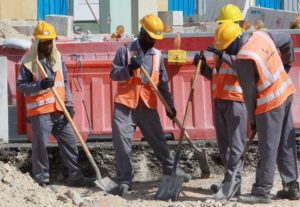The latest analysis by the International Labour Organization (ILO), on the impact of COVID-19 on the labour market shows massive damage to working time and income.
” Prospects for recovery in 2021 are slow, uneven and uncertain and needs early improvements supported by human-centred recovery policies,” the seventh edition of the ILO Monitor: COVID-19 and the world of work estimates.
The unprecedented disruption in 2020 due to the COVID-19 pandemic has led to greater job loss, four times greater than that during the global financial crisis over a decade ago.
New annual estimates in the seventh edition of the ILO Monitor: COVID-19 and the world of work confirm the massive impact that labour markets suffered last year. The latest figures show that 8.8 percent of global working hours were lost for the whole of 2020 (relative to the fourth quarter of 2019), equivalent to 255 million full-time jobs or approximately quadruple the jobs lost during the 2009 global financial crisis.
Women have been more affected than men due to labour market disruptions led by the pandemic. Globally, employment losses for women stand at 5 per cent, versus 3.9 per cent for men. In particular, women were much more likely than men to drop out of the labour market and become inactive.
Younger workers have also been particularly hard hit, either losing jobs, dropping out of the labour force or delaying entry into it. The employment loss among youth (15-24 years old) stood at 8.7 per cent, compared to 3.7 per cent for adults.
These lost working hours has affected 114 million people.
Significantly, 71 percent of these employment losses or 81 million people came in the form of inactivity, rather than unemployment, meaning that people left the labour market due to unable to work, perhaps because of pandemic restrictions, or simply, ceased to look for work. Looking at unemployment alone drastically understates the impact of COVID-19 on the labour market.
These massive losses resulted in an 8.3 per cent decline in global labour income, equivalent to USD 3.7 trillion or 4.4 per cent of global Gross Domestic Product (GDP).
The worst affected sector has been accommodation and food services, where employment declined by more than 20 per cent, on average, followed by retail and manufacturing. In contrast, employment in information and communication, and finance and insurance, increased in the second and third quarters of 2020. However, mining, quarrying and utilities, witnessed a marginal growth.
The report shows the uneven impact on different economic, geographic, and labour market sectors. It highlights concerns of a “K-shaped recovery”, whereby those sectors and workers hit hardest could be left behind in the recovery, leading to increasing inequality, unless corrective measures are taken.
According to ILO, nearly 3.7 million workers earn their livelihoods in the labour sector in Nepal. Nearly four in every five workers most vulnerable to disruption during the lockdown were in the construction, manufacturing and trade sectors.
Between 1.6 and 2.0 million jobs were likely to be disrupted in the Covid crisis (lockdown and restrictions ), either with complete job loss or reduced working hours and wages. In total, 631,000 female jobs (24.3 percent of the 2018 female workforce) were estimated as at risk in the higher impact scenario, compared to 1.3 million jobs for men (also 30.3 percent of the 2018 male workforce).
Within the at-risk sectors, the female share of employment is low in many in construction and manufacturing. As a result, the share of men’s employment at risk of disruption due to Covid-19 is higher than women’s.

